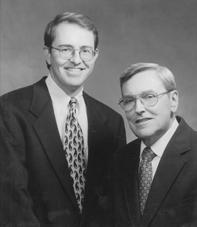
|
Board Certified Ocularist, the American Society of Ocularists |
|
 |
|
 The
eye was a symbol of life to the ancient world, particularly in Egypt, where
bronze and precious stone eyes were placed on the deceased. The Romans decorated
statues with artificial eyes made of silver. The
eye was a symbol of life to the ancient world, particularly in Egypt, where
bronze and precious stone eyes were placed on the deceased. The Romans decorated
statues with artificial eyes made of silver. 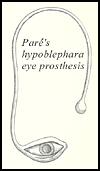 Ambrose
Paré (1510-1590), a famous French surgeon, was the first to describe the
use of artificial eyes to fit an eye socket. These pieces were made of gold
and silver, and two types can be distinguished: ekblephara and hypoblephara,
intended to be worn in front of or under the eyelids, respectively. A hypoblephara
eye was designed to be used above an atrophic eye, as enucleation was not
a common practice until the middle of the 1800s. Ambrose
Paré (1510-1590), a famous French surgeon, was the first to describe the
use of artificial eyes to fit an eye socket. These pieces were made of gold
and silver, and two types can be distinguished: ekblephara and hypoblephara,
intended to be worn in front of or under the eyelids, respectively. A hypoblephara
eye was designed to be used above an atrophic eye, as enucleation was not
a common practice until the middle of the 1800s. |
|
|
|
As with most things that evolved over time, it is difficult to trace the inventor of the artificial glass eye, but William Shakespeare (1564-1616) knew of its existence:
Get three glass eyes; |
| Enamel prostheses (1820s-1890s) were attractive but were expensive and not very durable. The introduction of cryolite glass, made of arsenic oxide and cyolite from sodium-aluminum fluoride (Na6A2F12), produced a grayish-white color suitable for a prosthetic eye. German craftsmen are credited with this invention in 1835. To make these glass eyes, a tube of glass was heated on one end until the form of a ball was obtained. Various colors of glass were used like paintbrushes to imitate the natural color of the eye. |
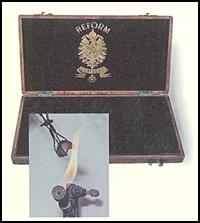
|
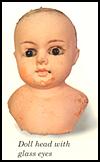
|
The glass art form flourished in France and Germany where fabricating secrets were handed down from one generation to the next. The town of Lausche, Germany, had a particularly rich history in both decorative (doll eyes, Christmas ornaments) and prosthetic arts. In the 19th century, German craftsmen (later coined "ocularists") began to tour the United States and other parts of the world, setting up for several days at a time in one city after another where they fabricated eyes and fit them to patients. Eyes were also fitted by mail order. |
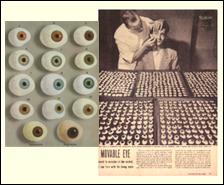 |
Stock eyes (or pre-made eyes) were also utilized. An "eye doctor" might keep hundreds of glass stock eyes in cabinets, and would fit patients with the best eye right out of the drawer. |
| In the United States, eyes continued to be made of glass until the onset of World War II, when German goods were limited and German glass blowers no longer toured the United States. The United States military, along with a few private practitioners, developed a technique of fabricating prostheses using oil pigments and plastics. Since World War II, plastic has become the preferred material for the artificial eye in the United States. |
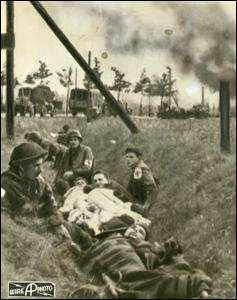
|
Virginia's History of Eye Making |
|
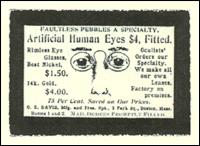
|
In the early 1800s, most people in Virginia and in the surrounding areas relied on imported, German-made, glass (stock) artificial eyes following surgery. Patients were fit by the local oculist, who was the equivalent of today's ophthalmologist. |
| During the 1850s, several German-founded companies started custom-making prostheses in New York City. Craftsmen sold eyes to regional eye care practitioners, or mailed semi-custom pieces to individuals. For more custom work, an individual needed to travel to New York City or Philadelphia to have a custom prosthesis hand-blown from scratch. |
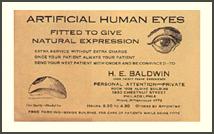
|
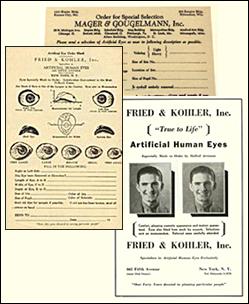
|
In the 1920s, several of these glass eye companies started to travel to various cities, once a month, to make prostheses for patients. The New York firm of Fried and Kohler, which consisted of brothers, Irwin and Hugo Kohler, traveled to Richmond to work with Salo and Joseph Galeski of Galeski Optical. Mager and Gougelmann (also of New York City) traveled to Norfolk (working with Traylor Optical) and eventually set up satellite offices in Washington, D.C. and Baltimore, Maryland. |
| By the mid-1940s, glass eyes were being replaced by plastic counterparts. In Virginia, this was led by Joseph Galeski (of Richmond, Virginia),although American Optical and several military hospitals started to experiment and dispense plastic artificial eyes. |

|
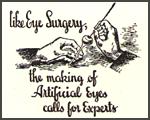
|
Present day ocularistry has evolved through the invention and technique of many individuals. The birth of the American Society of Ocularists (1957) and the refinement of ocular implants and surgical procedures have greatly improved the end results that ocularists can achieve. |
Ocular Implants |
|
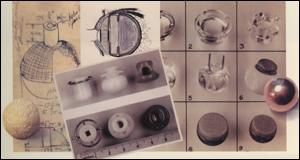
|
An ocular implant replaces the lost volume of the natural eye. The first account of placing an implant in the socket, following enucleation, was in 1841. Implants have been made of many different materials, shapes, and types throughout the years. It also helps the artificial eye to have some degree of movement. |
History of the Artificial Eye Clinic |
|
|
Fairfax/ Vienna,
Virginia.
|
|
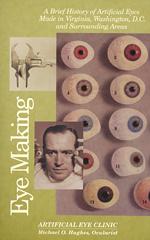
|
A more in-depth look
into the History of Ocular Prostheses is available in the booklet: Eyemaking.
Please call our office at: Click here to preview
this booklet: |
 |
|

